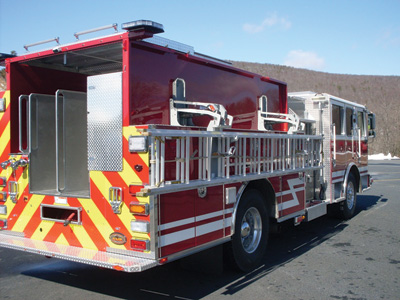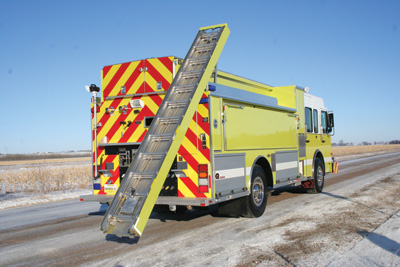Alan M. Petrillo
Apparatus manufacturers continue to refine the methods they use to store ground ladders on pumpers, often responding to fire department requests for placement of the ladders on a vehicle to correspond with ladder protection, access, or more usable compartment space.
Various Methods
Jason Witmier, pumper and tanker product manager for KME, acknowledges there are several different ways to store ladders on pumpers, often determined by priorities dictated by the fire department. For instance, he says, is the department carrying the standard pumper complement of ladders or does it require a special ladder package? National Fire Protection Association (NFPA) 1901, Standard for Automotive Fire Apparatus, requires that a pumper carry an extension, roof, and folding ladder.
Ladder storage on a pumper also can be determined by how often the ladders will be accessed, he says, if they need to be enclosed for protection from the environment, and whether the department is willing to sacrifice either compartmentation or water capacity to get the ladders in an ideal position.
“We do ladder storage in many of the traditional locations on a regular basis, like hung on the exterior of the apparatus above low compartments,” Witmier says. KME also mounts ladders in tank tunnels, he notes, or next to the water tank between the tank and the compartments. “We also do storage on powered ladder racks quite often, like the single-arm overhead hydraulic rack, dual-arm overhead hydraulic rack, and dual-arm compartment cap mounted electric ladder rack,” he adds.
 |
| (1) The rear of this KME-built pumper shows a vertical ladder tunnel on the officer’s side of the vehicle and two hard suction storage tunnels on the sides of the hosebed. (Photo courtesy of KME.) |
Ladder Racks
Scott Oyen, vice president of sales for Rosenbauer, says the older method of storing ground ladders over the low side compartments on the officer’s side of the truck is out of favor with fire departments. “The replacement for that is a ladder rack on top of the compartments that pivots down to give access from the ground,” Oyen says. “These ladder racks are either hydraulic or electric-over-hydraulic units with pivot arms at the end of an up to 15-foot body or dual pivots in the center of the rack’s body.”
Although Rosenbauer installs ladder racks made by other companies, such as a Zico electric ladder rack stored in the open over a three-quarter-high compartment, for example, Oyen says the company’s most common ladder racks are of its own construction. “All our power ladder racks store with the ladders laying flat,” he says. “When they come out over the side of the pumper’s body, the rack turns 90 degrees through a linkage to lay the ladders flat. We also have a Low Pro ladder rack where the mechanism comes to rest closer to the ground than the typical powered ladder rack.”
Oyen notes Rosenbauer makes another power ladder rack that comes off the top of the back of the pumper and angles out and down, similar to a pull-out and tip-down compartment tray. “The ladders slide down on a 45-degree angle and reach down to about waist high at their lowest point. The rack can be installed for either manual operation or electric over hydraulic,” he says.
 |
| (2) This KME-built pumper features a two-arm ladder rack positioned in the traditional spot on the officer’s side of a pumper above the low compartments. (Photo courtesy of KME.) |
Gaining Compartment Space
Grady North, product manager for pumpers, industrial and ARFF, at E-ONE, says that many departments are seeking to gain compartment space back where ladders had been traditionally located on the right sight of a pumper. “They are doing that in two ways,” North says. “One is a movable ladder rack, and the other is a ladder storage tunnel.”
North says E-ONE has found the most popular movable ladder racks are those that mount over high side compartments in an overhead rack. “A popular choice is the Zico single-arm ladder rack, operated electric over hydraulic, that is typically located over the wheel well area,” he says. “But in that configuration, you lose about 24 inches of compartment space. So, E-ONE developed a two-arm ladder rack that straddles the compartments and swings the rack out over them, gaining back that center storage space.”
North points out that the advantage of a two-arm unit is that it provides double the lifting capacity. “Our two-arm rack is an electro-hydraulic unit that is rated to 700 pounds,” he says. “You can put any combination of ladders and hard suction on that rack, and it is durability tested to 6,000 cycles.”
Ladder tunnels also are gaining in popularity, North observes. “The vertical tunnel is the one that’s most popular because there is a little less impact on the amount of water you lose in the tank,” he says. “Going through the water tank horizontally with a ladder tunnel takes a little more water capacity out of the tank.”
 |
| (3) Rosenbauer makes an electric-over-hydraulic ladder rack that comes off the back of a pumper and angles down at 45 degrees to allow ladders to be accessed from the ground. (Photo courtesy of Rosenbauer.) |
E-ONE has seen most of its vertical ladder tunnels installed on the officer’s side of pumpers, North notes, while through the tank horizontal ladder tunnels usually are centered in the rear of the vehicle, sometimes set high in the back, other times low.
Donley Frederickson, national sales manager for Rosenbauer, notes that ladder tunnels sometimes can be located underneath the “T” of a water tank, sitting on top of a low compartment but inside of the hosebed area, fully enclosed. “Often the ladders will protrude into the pump area,” Frederickson says. “If you do that, you can go with a body that’s shorter than the ladders and take up some unused pump space.”
More expensive options are those ladder tunnels that run through a water tank, Frederickson points out. In addition, some departments opt to carry their ladders in the hosebed area, above the water tank and covered by a hosebed cover. “That’s more of a pumper-tanker layout,” Frederickson says. “Sometimes that area is enclosed with doors, but usually those aren’t the first ladders used at a scene. It’s not very easy to get up there.”
Enclosed Ladder Storage
Witmier points out that ladder storage inside the body of the pumper or through the tank offers both benefits and drawbacks. “One primary benefit is the ladders are not exposed to the elements, so you don’t have the sun deteriorating the halyard and the rain on the ladder, which could freeze and cause issues,” he says. One disadvantage he cites is that, “Many times when the ladders are enclosed in a tank tunnel or inside the body, they are at a height that brings them out at chest or head height, which can be more difficult to maneuver and slide in or out.”
 |
| (4) Alexis Fire Equipment Co. built this pumper with a ladder tunnel built through the top of the water tank. (Photo courtesy of Alexis Fire Equipment Co.) |
Chad Trinkner, market manager for aerials, pumpers and fire suppression at Pierce Manufacturing Inc., says Pierce recently designed an enclosed ladder storage area on a pumper destined for the Skokie (IL) Fire Department. “Their number-one concern was safety for their firefighters and room for the officer and driver,” Trinkner says. “We designed the pumper on a Dash CF chassis and PUC pump but put more than 250 hours into reconfiguring the hosebed and ladder storage area.”
The Skokie Fire Department wanted the hosebed to be as low as possible, so Pierce designed all preconnects at the rear of the truck on low poly trays for easy accessibility. For the standard complement of pumper ground ladders, Pierce enclosed them in the traditional location on top of the officer’s side low compartments.
“We enclosed the ladders to protect them from the environment in Illinois,” Trinkner notes, “and kept them located down low so they could be accessed more easily. Looking at the right side of the pumper, it looks like full compartmentation on the officer’s side.”
Dan Reese, general manager of Alexis Fire Equipment Co., says that ladder storage is an element that needs to be planned in apparatus design. “A hydraulic ladder rack is a more popular way to store ladders if you have the money and the apparatus height,” Reese says. “In some cases, the ladders are exposed to the elements. We also have enclosed ladders on a ladder rack. But at that point, watching the weight of what is on the ladder rack is critical.”
He adds that in addition to ladders, pike poles and hard suction hose often are also stored on a hydraulic ladder rack.
ALAN M. PETRILLO is a Tucson, Arizona-based freelance writer and is a member of the Fire Apparatus & Emergency Equipment editorial advisory board. He served 22 years with the Verdoy (NY) Fire Department, including in the position of chief.

